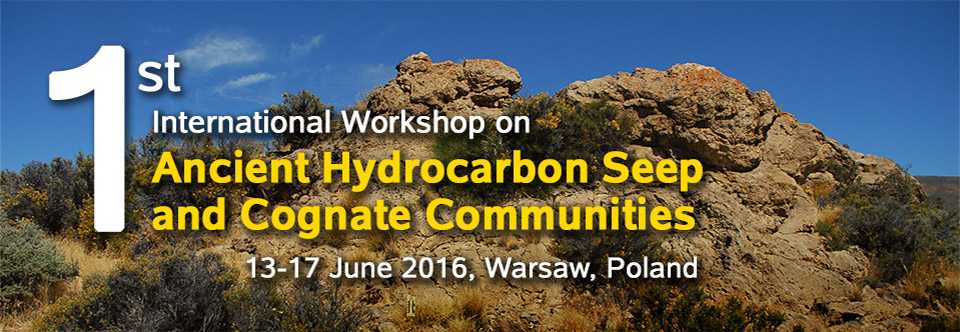
PALEOCENE METHANE SEEP COMMUNITY FROM SPITSBERGEN, SVALBARD
Krzysztof HRYNIEWICZ1, Maria Aleksandra BITNER1, Ewa DURSKA2, Robert G. JENKINS3, Jonas HAGSTRÖM4, Hanna Rósa HJÁLMARSDOTTIR5, Yusuke MIYAJIMA3, Crispin T.S. LITTLE6, Hans Arne NAKREM7, and Andrzej KAIM1
1Institute of Paleobiology, Polish Academy of Sciences, ul. Twarda 51/55, 00-818 Warszawa, Poland; 2Faculty
of Geology, University of Warsaw, al. Żwirki i Wigury 93, 02-089 Warszawa, Poland; 3College of Science and
Engineering, Kanazawa University, Kanazawa 920-1192, Japan; 4Swedish Museum of Natural History; P.O. Box
50007; SE-104 05 Stockholm, Sweden; 5University Centre of Svalbard, P.O. Box 156, N-9171 Longyearbyen;
6School of Earth and Environment, University of Leeds, Leeds LS2 9JT, UK; 7Natural History Museum, University
of Oslo, 1172 Blindern, 0318 Oslo, Norway.
Corresponding author: krzyszth@twarda.pan.pl
A new Paleocene seep locality is reported from Fossildalen on Spitsbergen, Svalbard. This is one of
a very few seep communities of latest Cretaceous–earliest Paleogene age, and the best preserved
Paleocene seep community known so far. The seep carbonates and associated fossils have been
first identified in museum collections, and subsequently sampled from the weathered outcrops of
the Basilika Formation. A frequent feature of the Basilika Formation is the occurrence of glendonites–
pseudomorphoses after the cold-water authigenic carbonate mineral ikaite. The seep deposit
comprises wood-rich carbonate blocks and numerous carbonate-filled invertebrate fossils, scattered
within turbiditic deposits. The isotopically light composition (δ13C approaching -50‰ V-PDB)
and characteristic petrographic textures of the carbonates are consistent with their formation at a
methane seep. The invertebrate fauna associated with the Fossildalen seep carbonates is of moderate
diversity (16 species) and is almost exclusively composed of “background” species, testifying
for its shallow water origin. However, the fauna is less diverse than other fossil shallow water seep
faunas, which could result from the destructive activity of turbidity currents, low ambient seawater
temperatures, or from a general impoverishment of marine faunas in the Paleocene. Fossildalen
seep carbonates are characterized by mass accumulations of a thyasirid bivalve belonging to
Conchocele, similar to mass accumulations of Conchocele in other latest Cretaceous and Cenozoic
cool-water seeps. So far we did not find any bathymodiolin and vesicomyid bivalves, which is in
agreement with the Eocene emergence of both clades and the Eocene origin of the “modern” seep
fauna.
